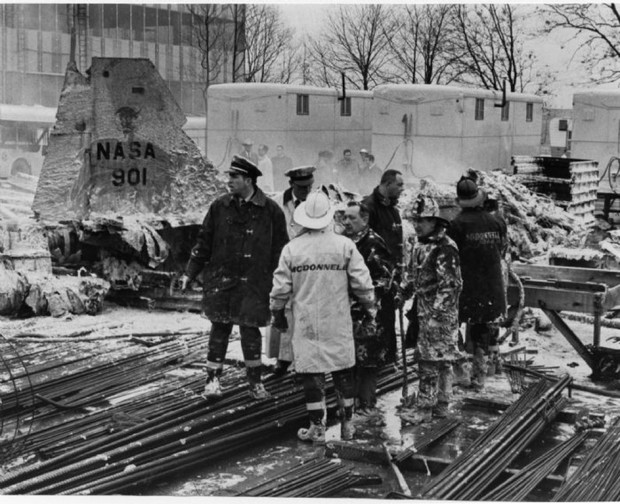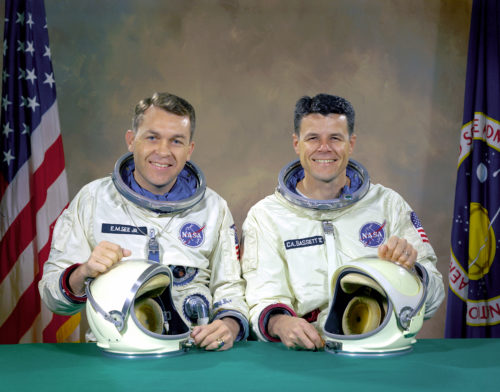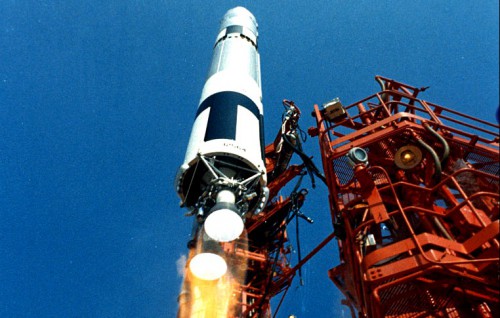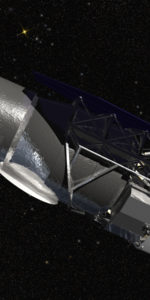
At 7:41 a.m. CST on 28 February 1966—exactly 50 years ago, to this very day—a pair of sleek T-38 Talon jets took off from Ellington Field, near the Manned Spacecraft Center (MSC) in Houston, Texas, heading for Lambert Field in St. Louis, Mo. Aboard the first jet, tail-numbered “NASA 901”, were astronauts Elliot See and Charlie Bassett, the prime crew for the upcoming Gemini IX mission, targeted for launch no sooner than 17 May 1966. Following them in the second T-38, tail-numbered “NASA 907”, were their backups, Tom Stafford and Gene Cernan. According to fellow astronaut Mike Collins in his memoir Carrying the Fire, flight rules forbade a member of a prime crew member to fly with his counterpart on the backup crew, “lest a crash wipe out the entire capability in one specialty”.
Tragically, that flight rule held true on the fateful morning of 28 February 1966.
As outlined in yesterday’s AmericaSpace history article, See and Bassett had been named as the prime crew of Gemini IX in November 1965, tasked with executing a mission of between two and three days in length at some point between May and July 1966. During the course of the flight, See would lead the rendezvous and docking with an unpiloted Agena target vehicle, whilst Bassett would become America’s third spacewalker, donning an Air Force-built Astronaut Maneuvering Unit (AMU) to perform a variety of activities in the near-vacuum of space. Over the course of several months of training, See had flown 25 times and Bassett seven times to St. Louis, in order to visit the McDonnell Aircraft Corp., where their Gemini IX spacecraft was being built. The flight from Ellington Field to Lambert Field took approximately 90 minutes and on the morning of 28 February 1966 See and Bassett, together with Stafford and Cernan, were headed to St. Louis for ten days of intensive rendezvous training on the Gemini simulator. They would also have the opportunity to view their spacecraft as it approached completion on the McDonnell production line.
The previous day, a Sunday, had been uneventful. See and his family had attended a religious service in downtown Houston, followed by the Livestock Show and Rodeo in the Astrodome, whilst Bassett had joined them for the rodeo. Both men rose early on Monday morning—with See described as good-humored as he ate a breakfast of cereal, juice and toast and Bassett going for a run, ahead of his own hot breakfast and coffee—before heading to Ellington and proceeding to the flight line. They filed their flight plans and loaded the baggage of both the prime and backup crews into NASA 901.

Following takeoff, the two aircraft quickly reached a cruising altitude of 41,000 feet (12,500 meters) and traveled in formation. “As Stafford eased up into position on See’s wing, he and Cernan could easily make out the other two pilots with their white helmets,” wrote space historians Colin Burgess, Kate Doolan and Bert Vis in their book Fallen Astronauts. Forty minutes into the flight, a radio check with the Little Rock Air Force Base Meteorological Office advised the crews that there was an overcast ceiling of 600 feet (180 meters) at St. Louis, together with visibility for two miles (3.2 km), as well as rain, fog and a broken ceiling. Conditions were not expected to change significantly, prior to the astronauts’ arrival in Missouri.
As the four astronauts approached St Louis, they entered murky conditions, with thick cloud, poor visibility and rain and snow flurries. At 8:48 a.m. CST, Lambert Field airport, situated within close to McDonnell’s plant, anticipated that the astronauts would follow standard procedures and perform instrument-guided landings. Descending through the cloud deck, the two jets appeared directly over the centerline of the southwest runway at 8:55 a.m. Both were much too low and traveling much too fast to achieve a landing. Stafford had remained in position on See’s right wing, but decided to ascend and perform a flyaround for another approach. He assumed that See would do the same. Inexplicably, though, See executed a tight turn to reach the runway. Years later, the only explanation for why he did this was that he wanted to beat the backup crew to the ground; an unusual act for a pilot who had earned a reputation for being both careful and judicious.
As See and Bassett’s jet vanished from sight, Stafford barked to Cernan in his backseat: “Goddammit, where’s he going?”
It was the last they saw of their comrades.
Minutes later, Stafford’s irritation was mounting, for the Lambert Field air traffic controllers had virtually ignored him and were vague in their communications. At length, he was close to declaring an emergency, so low was his fuel gauge, but eventually set NASA 907 safely onto the runway. He was puzzled by an odd question from the tower.
“Who was in NASA 901?”
“See and Bassett,” he replied.
He was told that McDonnell Aircraft had “a message” for him. A few minutes later, as Stafford opened his canopy, there was James McDonnell—“Mr. Mac” himself, aviation pioneer and founder of McDonnell Aircraft Corp.—waiting for them. In solemn tones, he explained that See and Bassett were dead.
In next few days, a picture of what happened became clear. After leaving Stafford and Cernan’s sight, it appeared that See realized he was heading directly for McDonnell Building 101—the very building in which the Gemini IX and X spacecraft were undergoing assembly—and that he could not land safely. Union Electric company linesman Kenneth Stovall was walking through a parking lot near the McDonnell plant when he heard the T-38 approaching. Quoted by Burgess, Doolan and Vis, he remembered seeing the aircraft descending at “a fairly sharp angle” and suddenly cutting in the afterburners.
From the front seat, Elliot See lit the afterburners, broke hard right and pulled back on the stick, but it was much too late. As evidenced in the subsequent accident investigation, a mere three seconds elapsed between See selecting afterburners and the moment of impact, by which time the right afterburner was in full thrust and its left-side counterpart was in the process of building power. Meanwhile, on the ground, Kenneth Stovall lost visual contact with the T-38 as it disappeared from view behind some stationary box-cars on the elevated railroad tracks at the northern end of the airfield. “I heard a roar and saw a ball of fire,” he said later. “I knew the pilots would be killed.” At 8:58 a.m. CST, the T-38 grazed the roof of Building 101, losing its starboard wing as it did so, and cartwheeled into a nearby parking lot. The jet promptly burst into flames.

Inside Building 101, foreman Damien Meert watched, aghast, from his desk as a sheet of flame rippled across the corrugated iron roof. His workers dived for cover under benches as fragments from the T-38’s shattered wing flooded into the building, hitting the Gemini X spacecraft. Other workers heard noises which they variously described as resembling sonic booms or the echo of thunder, as well as sudden flashes of fire and the manifestation of clouds of dust and fumes. Around a dozen McDonnell employees were injured by ceiling debris, including 19-year-old production worker Clyde Ethridge, who sustained a serious back injury.
Firefighters and police quickly converged on the crash site and sealed it off, as a mass of foam was dumped onto the fuselage as a precautionary measure against fire. Elliot See had been thrown clear of the fuselage and his corpse would be found in the parking lot, with his parachute half-opened. The gruesome discovery of Charlie Bassett’s severed head, jammed high in the rafters of Building 101, came later that day. Even the identification of the remains was difficult and not helped by the fact that all four men’s identification papers were in the baggage pod of See and Bassett’s jet. Only by checking with the men who were still alive was it possible to work out who had died. Dr. Eugene Tucker from the St. Louis County Hospital, who performed the autopsy, described the injuries as not dissimilar to those incurred by victims of a head-on traffic collision.
Both men died just 500 feet (150 meters) from Gemini IX.
Miracles seemed far from St Louis during that gloomy, overcast day on which See and Bassett breathed their last, but it is quite remarkable that no one on the ground was seriously injured and their spacecraft, Gemini IX, survived. If their T-38 had been a little lower when it hit Building 101, See and Bassett would have ploughed straight into the assembly line, destroying Gemini IX and X and probably killing hundreds of McDonnell’s skilled spacecraft construction workers. “Had they hit a couple of hundred feet earlier,” wrote Tom Stafford in his memoir, We Have Capture, “they would have hit the side and roof of the building, instead of just the end of the roof, and wiped out the whole Gemini program.” Project Gemini, which provided an indispensable stepping stone to the Moon, would have been over and the United States’ chance of reaching the lunar surface would have been seriously impaired.
Two days after the tragedy, on Wednesday, 2 March, with Stafford and Cernan now reassigned as Gemini IX’s prime crew, the spacecraft was loaded aboard a C-124 transport aircraft for delivery to Cape Kennedy in Florida. And on Friday, 4 March, the entire astronaut corps gathered in Section 4 at Arlington National Cemetery in Arlington, Va., to watch as the remains of 38-year-old Commander Elliot McKay See Jr. of the U.S. Naval Reserve and 34-year-old Captain (posthumously promoted to Major) Charles Arthur Bassett II of the U.S. Air Force were laid to rest.
An investigative board, chaired by Chief Astronaut Alan Shepard, found no defects in the T-38 and no problems with the physical or psychological state of See or Bassett. On paper, both men’s flying credentials were outstanding and both had renewed their instrument flying certificates within the last six months. The appalling weather was a contributory factor, but the board’s eventual consensus of “Pilot Error” came as no surprise to many in the astronaut office.
Elliot See in particular had been the only astronaut whose flying skills worried Deke Slayton, the head of Flight Crew Operations. The high-performance T-38 was unforgiving of errors and could easily stall at speeds of less than 270 knots; Slayton felt that See was overly cautious, flew too slowly and did not have the aggressive flying streak that the jet demanded of its pilots. Years later, in his memoir Deke, co-authored with Michael Cassutt, he admitted that he had gotten “sentimental” about See and had given him command of Gemini IX in the hope that Bassett would be strong enough to carry both of them. Ultimately, he wrote, “it was a bad call”. Others, including Neil Armstrong, have been more sympathetic. “There might have been other considerations that we’re not even aware of,” he told his biographer, James Hansen. “I would not begin to say that his death proves the first thing about his qualification as an astronaut.”
Of all the tragedies and disasters which affected America’s space program in the 1960s, the accident which took See and Bassett had greater consequences than could be anticipated. Three weeks after their deaths, Deke Slayton named Buzz Aldrin as Gemini IX’s new backup pilot and he eventually flew Gemini XII in November 1966. Had it not been for the accident, Aldrin almost certainly would not have been the Lunar Module Pilot (LMP) of Apollo 11 or the second man to walk on the Moon. This irony was not overlooked by Aldrin; for Charlie Bassett was both a close friend and a neighbor.
According to Slayton, in his memoir, Deke, had the accident not occurred and had Gemini IX flown successfully, Elliot See would have gone on to serve as backup command pilot for Gemini XII, before possibly rotating into the Apollo Applications Program (AAP), which later became Skylab. Meanwhile, Charlie Bassett was pointed toward a role as senior pilot for one of the early Apollo missions, which might have suitably positioned him to command a lunar landing flight. Moreover, the two men who ultimately flew the mission, redesignated “Gemini IX-A”, in June 1966, would later carve their own niches in history: Stafford would command the final dress rehearsal for the first lunar landing, whilst Cernan is still known to history as the “Last Man on the Moon”.
This is part of a series of history articles, which will appear each weekend, barring any major news stories. Next week’s article will focus on the 15th anniversary of STS-75, which saw three nations represented aboard Space Shuttle Columbia and the second mission of the Tethered Satellite.
Be sure to “Like” AmericaSpace on Facebook and follow us on Twitter: @AmericaSpace





Ben, thank you for an excellent series on such a tragic event.
I was in 3rd grade at the time, my dad worked at MAC at that time in F4 production, I remember the accident very well still today and that one of the astronauts was decapitated it was a very sad day in the St.Louis area that day
My grandfather was a firefighter for McDonald Douglas when this happened. I have photos he gave me before he passed of that day. The fire and damage to the building they hit with my grandfather on the roof of the building. He talked about this accident only once and showed me the photos, it was a terrible day for all involved.